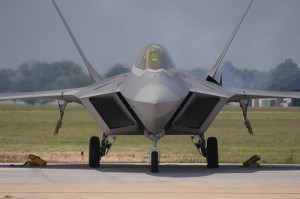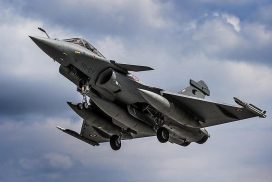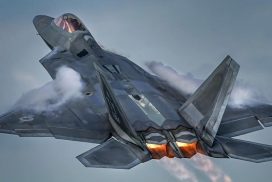A few weeks back we saw the internet buzzing with photographs showing Beijing’s first stealth fighter jet, the Chengdu J-20. The J-20 prototype was first photographed when it was preparing for high-speed taxing trial at the CAC airfield on December 22, 2010. Chengdu J-20 China has also carried out the test flight of its advanced laser-evading stealth fighter. The J-20 stealth fighter is proof to China’s rapid advancement in military aviation technology. It was also highly speculated that China stole the J-20 design from F-22 Raptor and Mig 1.44 .Lets go ahead and look into the details.
Similarities with the MIG-1.44
J-20

The latest images show some startling similarities between the Chinese J-20 and canceled Russian MiG-1.44. Both have similar style of delta wing canard configurations and V-Shaped tail section with closely mounted engines. The frontal aspect looks extremely similar to that of the American F-35 JSF with DSI intake which has now become common on all new Chinese designs. However there are several differences that show it is not as optimized for air combat as the MiG. The control surfaces on its hinged ventral fins and on its tail booms flaps are absent on the J-20. Also the MiG was not compromised by stealth considerations as J-20.
MIG-1.44
 The J-20 might do okay on its current configuration but the MiG-1.44 had more control surfaces as a result of a very demanding high AoA behavior. The MiG-1.44 is not stealthy as the F-22 but it is for sure very agile for its size and weight as its inlet is designed to have more side slip resistance and better AoA behavior. The F-22 and J-20 have chines that stabilize them at high AoA and keeps them stable at yaw but the MiG.144 was designed as a pure aerodynamic aircraft with little stealth applied.
The J-20 might do okay on its current configuration but the MiG-1.44 had more control surfaces as a result of a very demanding high AoA behavior. The MiG-1.44 is not stealthy as the F-22 but it is for sure very agile for its size and weight as its inlet is designed to have more side slip resistance and better AoA behavior. The F-22 and J-20 have chines that stabilize them at high AoA and keeps them stable at yaw but the MiG.144 was designed as a pure aerodynamic aircraft with little stealth applied.
Similarities with the F22-Raptor
J-20
 The canopy looks like a 1:1 carbon copy of that on the F-22, right down to the v-shaped cylinder on the forward part of the frame. The J-20 has a canard delta layout (like Chengdu’s J-10) with two canted, all-moving vertical stabilizers (like the T-50) and smaller canted ventral fins. The stealth body shaping is similar to that of the F-22. The main landing gears retract into body-side bays, indicating the likely presence of F-22-style side weapon bays ahead of them. The ground clearance is higher than on the F-22, which would facilitate loading larger weapons including air-to-surface munitions. The cant angles are greater than they are on the Lockheed Martin F-35, and the frameless canopy is similar to that of the F-22.
The canopy looks like a 1:1 carbon copy of that on the F-22, right down to the v-shaped cylinder on the forward part of the frame. The J-20 has a canard delta layout (like Chengdu’s J-10) with two canted, all-moving vertical stabilizers (like the T-50) and smaller canted ventral fins. The stealth body shaping is similar to that of the F-22. The main landing gears retract into body-side bays, indicating the likely presence of F-22-style side weapon bays ahead of them. The ground clearance is higher than on the F-22, which would facilitate loading larger weapons including air-to-surface munitions. The cant angles are greater than they are on the Lockheed Martin F-35, and the frameless canopy is similar to that of the F-22.
F-22

The flat body sides are aligned with the canted tails, the wing-body junction is clean, and there is a sharp chine line around the forward fuselage. The cant angles are greater than they are on the Lockheed Martin F-35, and the frameless canopy is similar to that of the F-22. On a stealthy aircraft you need use internal volume, longer ducts that are surrounded by fuel and weapons bays. Features at the rear of the aircraft—including underwing actuator fairings, axisymmetrical engine exhausts and the ventral fins—appear less compatible with stealth, so the J-20 may not match the all-aspect stealth of the F-22. There are two possible explanations for this: Either the aircraft seen here is the first step toward an operational design, or China’s requirements do not place as much stress on rear-aspect signatures.
Cyber espionage theft speculations
Computer spies had broken into the Pentagon’s $300 billion Joint Strike Fighter project, the Defense Department’s costliest weapons program ever. Computer systems involved with the program appear to have been infiltrated at least as far back as 2007, according to people familiar with the matter. Evidence of penetrations continued to be discovered at least into 2008. The intruders appear to have been interested in data about the design of USAF planes, its performance statistics and its electronic systems. The intruders compromised the system responsible for diagnosing a plane’s maintenance problems during flight, according to officials familiar with the matter. However, the plane’s most vital systems — such as flight controls and sensors — are physically isolated from the publicly accessible Internet.
The intruders entered through vulnerabilities in the networks of two or three contractors helping to build the high-tech fighter jet, according to people who have been briefed on the matter. Lockheed Martin is the lead contractor on the program, and Northrop Grumman Corp , BAE Systems PLC also play major roles in its development. The spies inserted technology that encrypts the data as it’s being stolen , as a result, investigators can’t tell exactly what data has been taken.

Amongst high speculation of Chinese involvement in these events , investigators traced the penetrations back with a “high level of certainty” to a known Chinese Internet protocol, or IP, addresses and digital fingerprints that had been used for attacks in the past. A Pentagon report issued had stated that the Chinese military has made “steady progress” in developing online-warfare techniques. China hopes its computer skills can help it compensate for an underdeveloped military, the report said. The Chinese Embassy said in a statement that China opposes and forbids all forms of cyber crimes.” It called the Pentagon’s report “a product of the Cold War mentality” and said the allegations of cyber espionage are “intentionally fabricated to fan up China threat sensations.”
There were also reports on some forums that F-22 was spotted over Beijing. This photograph looks suspicious





